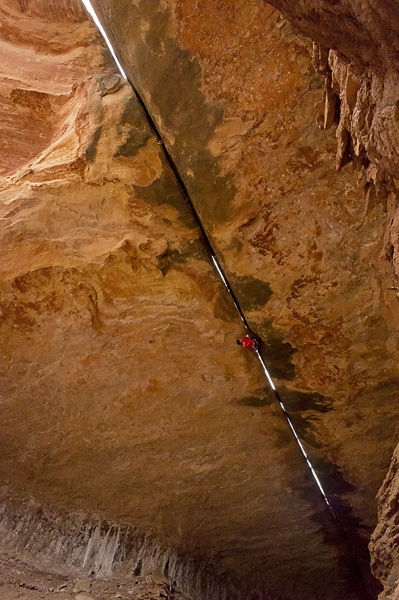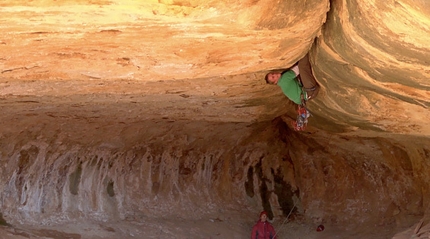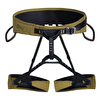Century Crack, the hardest offwidth in the world?

 1 / 2
1 / 2 Steve Bartlett
Steve Bartlett
On 5 October 2011 Tom Randall and Pete Whittaker carried out an impressive ascent of what is currently being hailed as one of the hardest and longest offwidth cracks in the world. Located on the underbelly of White Rim in Utah's Canyonlands, the stunning horizontal 40m crack was first discovered by Steve "Crusher" Bartlett who carried out the first ascent in 2001. At the time Bartlett climbed his "Chocolate Starfish" solo and with the use of aid (A1) and in doing so he threw down the gauntlet for the the obvious challenge: climbing the route free.
The roof lay dormant until one of the world's most talented and underrated climbers, Britain's Stevie Haston, turned his attention to the crack. Adhering to strict local ethics and a no-compromise approach, Haston made a series of valiant efforts but then abandoned his attempts; the British climber used to strip his gear off what had now become known as 'Century Crack', a feat which left him understandably wasted for days. Others had attempted the crack in during the last decade, but success remained elusive.
With this particular route in mind Randall and Whittaker trained intensively for years and after their recent "warm-up" visit to Vedauwoo they travelled straight to Canyonlands. Upon their arrival on Tuesday 4 October they adopted different tactics: after working the line for a day, the following morning they quickly dispatched with the roof as first Randall, then Whittaker, sent the crack with pre-placed gear.
At present a grade has not been put forward and while the feat is undeniably world-class (both define this as the climbs of their lives), the pinkpoint style of ascent has raised eyebrows both in Britain and the US as many consider freeing the route with pre-placed gear as unethical. In particular on a such a long and overhanging route where additional weight and the art of placing the camming devices is an all-important issue.
Commenting extensively on UKclimbing, Randall stated "...we found the pre-placing of friends actually somewhat balanced out the difficulties of the climbing, as each one presented a new crux as climbing round the cam was so tricky. It's always difficult to say conclusively how different it all is, but I'm certain we've taken no short cut here!" He concluded "Whilst it would be ideal to have placed the gear on lead during each of our attempts, the practicalities of it made it almost impossible. The mere cleaning of the route would waste one person so much that they'd have to sacrifice a whole day's high level climbing, which wasn't possible as we were down there for only 2 days. If we had more than 2 days down there I'm 100% certain we'd do it in that style too."
Given the unique beauty and importance of this plum line though, it wouldn't surprise us if it were to receive a free ascent in the near future, this time without any pre-placed gear. Perhaps even by the boys themselves, much like Swissman Didier Berthod who after his pinkpoint ascent of Greenspit in Italy's Valle dell Oro returned two years later to settle off unfinished business and place all the gear on lead. Randall and Whittaker evidently had plenty of margin on the route - they both sent it first go on their second day - and perhaps one day they will return to this trophy with time as an ally and not a foe.
Steve "Crusher" Bartlett was at hand to witness the ascent. He has kindly shared his views below.
CENTURY CRACK
by Steve "Crusher" Bartlett
Pete Whittaker and Tom Randall (both climbers led Century Crack, one right after the other) have pulled off a free lead of what is quite likely the longest roof crack in the world (120 feet long!). Probably also the hardest offwidth crack ever climbed (weighing in at around low-end 5.14). They trained for two years to master the skills and unreal strength required, and the training paid off in spades. I missed Tom's performance, but I did watch from above as Pete carefully eased his way, upside-down, along the roof. This took fifteen minutes or so, an incredible display of perseverance that was hard to watch. After 80 feet of hanging upside down, he seemed rested, relaxed, focused, ready and primed to crank his way though the tricky, merely overhanging finish.
I aid-climbed this crack in 2001, calling it the Chocolate Starfish. As an aid climb, it is no real challenge, but it IS a unique feature: a novelty route and a lot of fun! It was Stevie Haston who first saw the potential for free climbing the crack. I told Stevie about the climb. He worked on it, and I recall he told me he managed to climb it with about three rests. Stevie named the project Century Crack, wrote it up in a magazine article, intended returning. Tom and Pete read Stevie's article, were inspired (Stevie is one of the world's strongest and most inspiring free climbers) to try to climb the thing themselves. One or two other folks have been on the climb since 2001, trying it, without success. It has not been free climbed until now because it is so extremely difficult. It is, in a way, sheer genius that Tom and Pete understood that highly specific indoor training might be more relevant to success on this freak of nature than a conventional approach of ascending other offwidth climbs.
Watching Pete sending Century Crack was definitely one of the all-time best displays of rock climbing I've ever seen. And that's saying something. I've been climbing over 30 years. In that time, I've witnessed many top climbers: Lynn Hill boldly launching herself up the then-aid climb Vandals; a gifted, inspired Skip Guerin displaying a cat-like grace on the boulders; a young Jerry Moffatt demonstrating his own gift of brute determination and hunger, Ben Moon cruising the Eldorado testpiece Rainbow Wall for its first onsight flash. These ascents are engraved on my brain—the very best climbers pulling it all together, showing the rest of us the potential that we all have, if we could only dig as deep. Thanks Pete and Tom!



 Copia link
Copia link


























